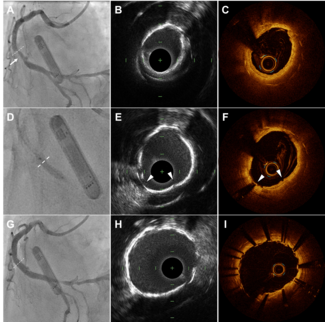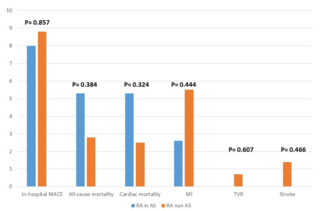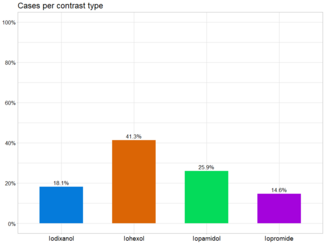Intravascular Lithotripsy for In-Stent Calcified Neoatherosclerosis
© 2025 HMP Global. All Rights Reserved.
Any views and opinions expressed are those of the author(s) and/or participants and do not necessarily reflect the views, policy, or position of the Journal of Invasive Cardiology or HMP Global, their employees, and affiliates.
J INVASIVE CARDIOL 2025. doi:10.25270/jic/25.00073. Epub April 9, 2025.
An 80-year-old man with a history of acute inferior myocardial infarction was admitted to our hospital. He had undergone bare-metal stent (3.5/28 mm) implantation in the mid-right coronary artery 22 years prior.Drug-induced myocardial perfusion imaging revealed perfusion defects in the peri-infarction lesion, accompanied by left ventricular hypokinesis during stress. Coronary angiography demonstrated in-stent restenosis (ISR) in the distal segment of the stent (Figure A). Given these findings, we planned revascularization for this ISR lesion.
Intravascular ultrasound (IVUS; Altaview, Terumo) revealed neointima with a circumferential high-intensity surface, suggesting calcified neoatherosclerosis (Figure B). Optical coherence tomography (OCT) (Dragonfly Opstar; Abbott) further confirmed the presence of circumferential calcified plaque with a maximum thickness of 200 µm (Figure C, Video 1). With the aim of creating fractures in this calcified neointima to achieve luminal gain, we performed intravascular lithotripsy (IVL) (Shockwave C2 3.5/12 mm; Shockwave Medical) (Figure D). Subsequent IVUS and OCT showed the formation of multiple cracks within the calcified plaque (Figure E and F, Video 2). Finally, a new everolimus-eluting stent (4.5/20 mm) successfully dilated the lesion (Figure G-I, Video 3). The procedure was completed without complications, and the patient has remained free of symptoms since the intervention.
Inadequate luminal gain in the treatment of calcified neoatherosclerosis may contribute to recurrent restenosis. Achieving sufficient lesion dilation in severe in-stent calcification requires an effective strategy to disrupt the calcified tissue. Although clinical data on IVL for ISR remain limited, this case highlights the potential of IVL in facilitating lesion expansion in calcified neoatherosclerosis. IVL is a simple and effective technique with a low incidence of slow flow, and its application in managing calcified coronary lesions is steadily increasing. Further dedicated studies are warranted to evaluate the efficacy of IVL in treating significant in-stent calcification.

Affiliations and Disclosures
Keima Wayama, MD; Kota Murai, MD, PhD; Teruo Noguchi, MD, PhD
From the Department of Cardiovascular Medicine, National Cerebral and Cardiovascular Center, Osaka, Japan.
Disclosures: The authors report no financial relationships or conflicts of interest regarding the content herein.
Consent statement: The authors confirm that informed consent was obtained from the patient for the intervention described in the manuscript and for the publication thereof.
Address for correspondence: Kota Murai, MD, PhD, Department of Cardiovascular Medicine, National Cerebral and Cardiovascular Center, 6-1 Kishibe-Shinmachi, Suita, Osaka 564-8565, Japan. Email: murai.kota11@ncvc.go.jp; X: @murahyon


















